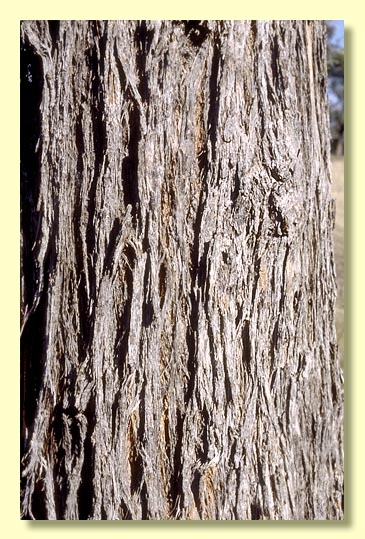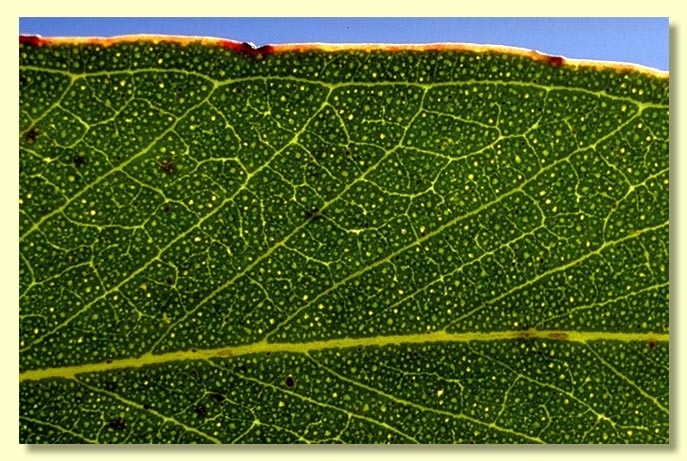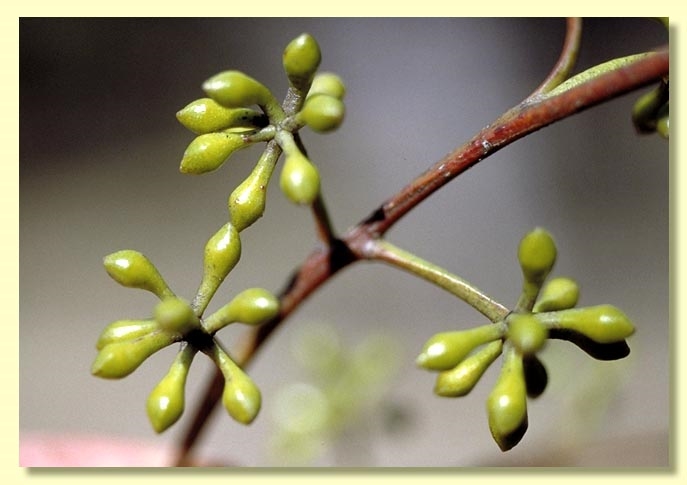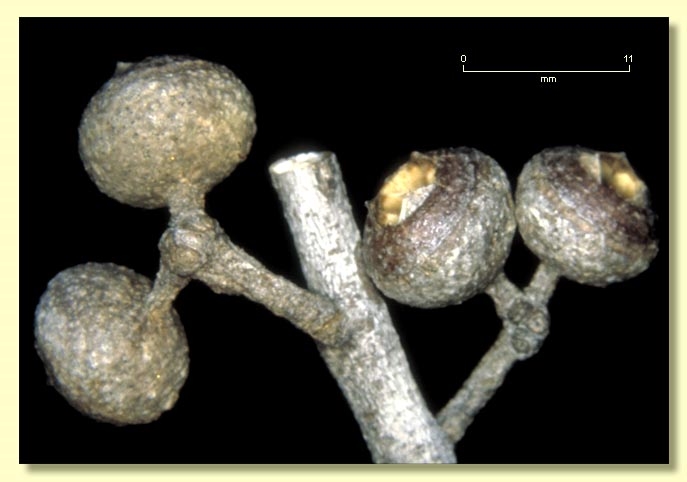Euclid - Online edition
Eucalyptus laevopinea
Eucalyptus | Eucalyptus | Capillulus | Pachyphloius
T: New South Wales. Nulla [Nullo] Mtn [near Rylstone], J. Dawson s.n., 3 August 1898; lecto BRI [AQ099608], isolecto: K [K000279885]; fide Bean, A.R., Telopea 12(3): 313 (2009).
Eucalyptus macrorhyncha var. brachycorys Benth., Fl. Austral. 3: 207 (1867). T: New England, NSW, C.Stuart s.n.; holo: MEL; iso: NSW.
Tall tree to 40 m tall. Forming a lignotuber.
Bark rough on trunk and larger limbs, stringy, thick, grey, or grey-brown; branches smooth, whitish-grey.
Juvenile growth (coppice or field seedlings to 50 cm): stem rounded in cross-section, scabrid; juvenile leaves sessile at first but soon shortly petiolate, opposite for 5 to 10 nodes then alternate, lanceolate to ovate, 3–12 cm long, 1–4 cm wide, margin entire, irregular or undulate, discolorous, glossy, green; stems, petioles, midrib and leaf margin scabrid at least to node 13.
Adult leaves alternate, petiole (0.8)1–2.3 cm long; blade lanceolate to falcate, 7–20 cm long, 1.4–4 cm wide, base usually oblique, margin usually entire but sometimes almost shallowly toothed, concolorous, glossy, green to grey-green, side-veins at an acute or wider angle to midrib, sparsely to moderately reticulate, intramarginal vein parallel to and well removed from margin, oil glands island.
Inflorescence axillary unbranched, peduncles 0.6–1.7(2.2) cm long, rounded to narrowly flattened, buds in umbels of 7, 9 or 11, pedicels 0.2–0.5(0.8) cm long. Mature buds obovoid, 0.5–0.7 cm long, 0.4 cm wide, yellow or green, scar absent, operculum rounded to conical to beaked, stamens irregularly flexed, anthers reniform to cordate, versatile, dorsifixed, dehiscing by confluent slits, style long, stigma tapered, locules 3 or 4, the placentae each with 2 vertical ovule rows. Flowers white.
Fruit usually pedicellate (pedicels (0)0.1–0.4 cm long), hemispherical or truncate-globose, (0.3)0.4–0.9 cm long, 0.7–1.5 cm wide, disc raised-convex or oblique to level, valves 3 or 4, exserted or near rim level.
Seeds brown, 1–3 mm long, pyramidal or obliquely pyramidal, dorsal surface smooth, hilum terminal.
Cultivated seedlings (measured at ca node 10): cotyledons reniform; stems rounded in cross-section, densely stellate-hairy only on lower part but scarcely scabrid by node 8 to 10; leaves sessile, opposite, elliptic, discolorous and scabrid on margins and midrib until ca node 6, then alternate, petiolate, broadly lanceolate, 6.5–13 cm long, 2.5–5.5 cm wide, base rounded but soon tending to oblique, margin irregular, now concolorous, green glossy and glabrous.
Flowering has been recorded in January, March, April, July, August and September.
A medium-sized to tall stringybark tree of the Central Western Slopes north from Rylstone and Merriwa to the North Western Slopes and Northern Tablelands of New South Wales extending to the Warwick and Stanthorpe area of south-eastern Queensland, with a possible outlier further north in the Carnarvon Range. It prefers hilly country and eastern escarpments, often on basalt soils, where it is a component of tall forests, but is also found on somewhat poorer soils as a woodland tree. Eucalyptus laevopinea has rough bark to the larger branches with the smaller branches smooth, concolorous glossy green adult leaves, pedicellate obovoid smooth non-angled buds and moderately large fruit with flat or raised disc. Juvenile leaves are ovate to lanceolate, discolorous, glossy green above and with scabridity on main veins and margins.
Among the stringybarks in this region E. laevopinea is distinguished from all others by the smooth branches and distinctly pedicellate, obovoid buds and large fruit up to 0.7–1.5 cm wide. The stringybark E. youmanii occasionally has smooth-barked branches but its buds are almost sessile and are longitudinally angled.
Other tall forest fibrous-barked species with smooth-barked branches occurring within the natural range of E. laevopinea are: the ash species E. andrewsii (two subspecies) and E. olida, which differ in having smaller cupular to campanulate fruit and glabrous juvenile growth with pendulous concolorous leaves; E. fastigata, which has much smaller obconical fruit, green glabrous juvenile leaves and a conspicuously ribbony crown due to shedding bark; and E. obliqua, which has green glabrous juvenile leaves and fruit with a descending disc and valves enclosed or just to rim level.
Eucalyptus laevopinea may resemble the Yellow Stringybark E. muelleriana of south-eastern New South Wales and eastern Victoria (there is no overlap in distribution), but that species differs in being completely rough barked and has juvenile growth scabrid only on lowest part, soon becoming glabrous.
MORE ABOUT STRINGYBARKS













